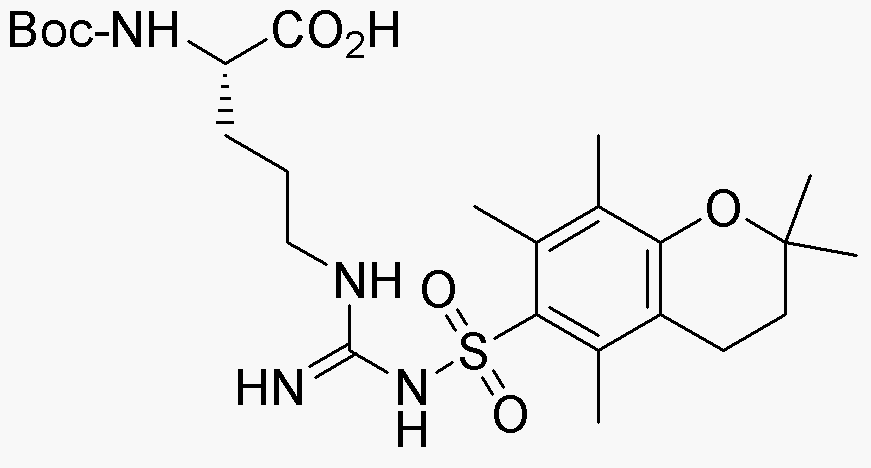Na-Boc-Nw-(2,2,4,6,7-pentamethylchroman-6-sulfonyl)-L-arginine is widely utilized in research focused on:
- Peptide Synthesis: This compound serves as a protective group for amino acids in peptide synthesis, enhancing the efficiency and specificity of reactions in pharmaceutical development.
- Drug Development: Its unique structure allows for the design of novel therapeutics, particularly in targeting specific biological pathways, which is crucial in the creation of new medications.
- Bioconjugation: It can be used in bioconjugation processes, linking biomolecules to create targeted drug delivery systems, improving the efficacy and reducing side effects of treatments.
- Research in Cancer Therapeutics: The compound is being explored for its potential in cancer research, particularly in developing targeted therapies that can selectively attack cancer cells.
- Enzyme Inhibition Studies: It is valuable in studying enzyme interactions and inhibitions, aiding researchers in understanding metabolic pathways and developing inhibitors for therapeutic applications.
Informations générales
Propriétés
Sécurité et réglementation
Applications
Na-Boc-Nw-(2,2,4,6,7-pentamethylchroman-6-sulfonyl)-L-arginine is widely utilized in research focused on:
- Peptide Synthesis: This compound serves as a protective group for amino acids in peptide synthesis, enhancing the efficiency and specificity of reactions in pharmaceutical development.
- Drug Development: Its unique structure allows for the design of novel therapeutics, particularly in targeting specific biological pathways, which is crucial in the creation of new medications.
- Bioconjugation: It can be used in bioconjugation processes, linking biomolecules to create targeted drug delivery systems, improving the efficacy and reducing side effects of treatments.
- Research in Cancer Therapeutics: The compound is being explored for its potential in cancer research, particularly in developing targeted therapies that can selectively attack cancer cells.
- Enzyme Inhibition Studies: It is valuable in studying enzyme interactions and inhibitions, aiding researchers in understanding metabolic pathways and developing inhibitors for therapeutic applications.
Documents
Fiches de données de sécurité (FDS)
La FDS fournit des informations de sécurité complètes sur la manipulation, le stockage et l’élimination du produit.
Spécifications du produit (PS)
Le PS fournit une description complète des propriétés du produit, notamment sa composition chimique, son état physique, sa pureté et les exigences de stockage. Il détaille également les plages de qualité acceptables et les applications prévues du produit.
Certificats d'analyse (COA)
Recherchez des certificats d'analyse (COA) en saisissant le numéro de lot du produit. Les numéros de lot et de lot se trouvent sur l'étiquette d'un produit, après les mots « Lot » ou « Lot de fabrication ».
Numéro de catalogue
Numéro de lot/série
Certificats d'origine (COO)
Ce certificat d'exploitation confirme le pays dans lequel le produit a été fabriqué, et détaille également les matériaux et composants utilisés et s'il est issu de sources naturelles, synthétiques ou autres sources spécifiques. Ce certificat peut être requis pour les douanes, le commerce et la conformité réglementaire.
Numéro de catalogue
Numéro de lot/série
Fiches de données de sécurité (FDS)
La FDS fournit des informations de sécurité complètes sur la manipulation, le stockage et l’élimination du produit.
DownloadSpécifications du produit (PS)
Le PS fournit une description complète des propriétés du produit, notamment sa composition chimique, son état physique, sa pureté et les exigences de stockage. Il détaille également les plages de qualité acceptables et les applications prévues du produit.
DownloadCertificats d'analyse (COA)
Recherchez des certificats d'analyse (COA) en saisissant le numéro de lot du produit. Les numéros de lot et de lot se trouvent sur l'étiquette d'un produit, après les mots « Lot » ou « Lot de fabrication ».
Numéro de catalogue
Numéro de lot/série
Certificats d'origine (COO)
Ce certificat d'exploitation confirme le pays dans lequel le produit a été fabriqué, et détaille également les matériaux et composants utilisés et s'il est issu de sources naturelles, synthétiques ou autres sources spécifiques. Ce certificat peut être requis pour les douanes, le commerce et la conformité réglementaire.


